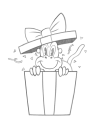Hey everyone, I'm Ben. I like to draw, paint, and sculpt, particularly in a stylized way. Today, I thought it'd be fun to hang out, answer questions, and stylize some portraits. I'll show you situations where I stick closely to the reference and others where I don't even look at it.
Learn more from Ben in his course Illustrating a Stylized Character!
Starting with Large Shapes
I always start with the largest shapes possible. The name of the game here is moving from large shapes to smaller shapes. It's going to look funky in the beginning, that's just the way it goes.
Transitioning Between 2D and 3D Thinking
I think of my process like a sliding scale between 2D thinking and 3D thinking. Initially, the shapes are very two-dimensional, like pieces of paper layered over each other. I don't transition linearly, I go back and forth between 2D and 3D as I work.
To bring a 2D shape into the 3D world, I start adding forms within those shapes. For example, understanding the forms of the face and adding 3D shapes within the 2D outlines helps create depth.
Building the Drawing
I like to sketch, knock it back by reducing the opacity, and then go over the top. I repeat this process, refining the drawing with each pass. When drawing heads, I have an understanding of the skull underneath, which helps with proportions and placement.
I'm not aiming for likeness here, I'm just going for fun and stylization. I'm building the drawing as I go, and I'm not trying to have the final image in my head before I start.
Flipping the Canvas
Using the flip shortcut helps me get a different perspective. It allows me to see mistakes I might have missed and ensures the drawing looks good from all angles.
Understanding Facial Features
The Nose
I often struggle with the nose, because of the small planes underneath. To tackle that, I think of the nose in simplified terms, almost like a pyramid. Thinking about the center line of the nose helps me understand its structure.
The Ears
A quick tip for ears: I like to use a simplified little backwards six or a forward six. Ears are fantastic for giving the head direction. Placing the ear correctly can automatically give a sense of the head's orientation, especially in profile views.
The Eyes
I think of the eyes as spheres within the sockets. The eyebrows wrap around the three dimensions of the head. One of my favorite lines for getting the direction and dimension of the face is from the brow to the eye socket down to the cheek.
The Eyebrows
The eyebrows and lower lids are superpowers for expressions. Adjusting them can completely change the character's look.
Drawing Hair as Big Basic Shapes
For the hair, I focus on big, basic shapes with no detail. Hair has direction and dimension, it wraps around the three-dimensional form of the head.
Simplifying Shapes
I see if I can find simple shapes to shade in. Sometimes, I see value more easily than lines. Blocking in abstract shapes for features like the mouth helps me visualize the character better.
Eye Direction Techniques
Getting the eye direction right is crucial. If I want a character to look at something specific, I imagine a line from the object to the sphere of the eye, then visualize a cylinder along that line. This helps me place the pupil and iris accurately.
Using the Lasso Tool
Don't be afraid to use the lasso tool to move stuff around. It's faster than erasing and redrawing. You can experiment by adjusting elements like the nose or ear placement quickly.
Using Style References
I recommend having style references next to you while drawing. Look at how different artists tackle challenges like noses and lips. Take a little bit from various artists and mix it to create your own style.
Expressions and Features
Pushing expressions by adjusting features like the eyebrows can add character to your drawings. For example, making the eyebrows taller or pushing them more can change the character's expression significantly.
Drawing Hands
When drawing hands, I like to block them in as groups of shapes. Keeping the shapes simple helps manage the complexity. Hands are tricky, so breaking them down into basic forms can make the process easier.
Working in Traditional vs. Digital
In traditional media, we don't have layers, so I have to be more deliberate with my decision-making. I look at the reference more than my drawing to ensure accuracy. In digital, I can erase, use layers, and adjust as I go, giving me more flexibility.
Introducing Colors and Values
I introduce colors at different stages, depending on the process I want to use. Sometimes I start adding values after refining the drawing, and other times, I block in color earlier. It's interchangeable for me.
Refining the Drawing
As I refine the drawing, I make sure all my shapes are understood. This way, I don't run into issues later on. I adjust features, push proportions, and sometimes add texturing with the line work to keep it interesting.
* * *
What I've shown you today is how I start an illustration with sketches and simple shapes, using photo reference but not sticking to it rigidly. Thinking in 3D gives me ultimate freedom to make whatever I want. I like stylized stuff, so I draw stylized stuff. If I want it less stylized and closer to the reference, I can do that too because I've got an understanding of those 3D forms.
Learn more from Ben in his course Illustrating a Stylized Character!







